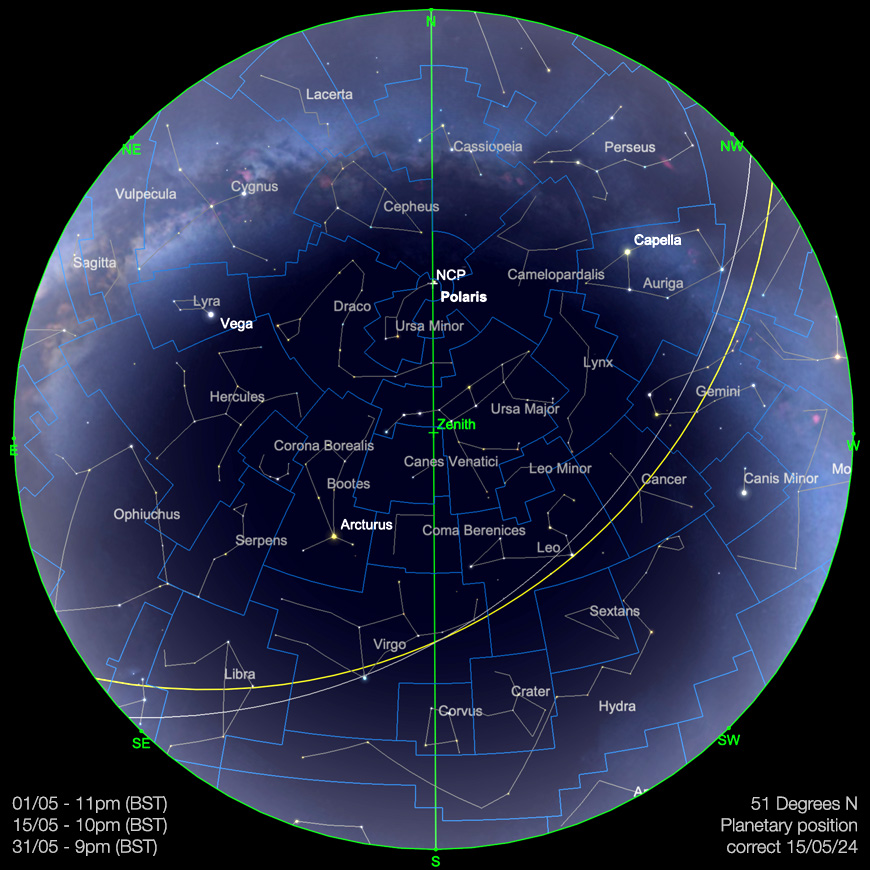For observers in the northern hemisphere, May is a time of transition. The Sun, having crossed over to the northern hemisphere of the sky in late March, is now entering the upper portion of the northern ecliptic plane.
The net effect of this for observers in higher northern latitudes is significant increase in the hours of sunlight experienced. Observers in lower northern latitudes will experience an increase in sunlight hours, but with much more of the planet in the way of the Sun, during darkness, this effect is much less pronounced. By late May, hours of darkness will have decreased significantly for those above 45° north and with this will also come an extension of astronomical twilight. Although we still have a little over three weeks to go before the technical point of Midsummer (20th/21st of June), by the end of May, it will not be difficult to detect the lighting of background sky conditions extending significantly even after the Sun has gone down.
At the beginning of May, taking 51° north as an example of observing situation, the Sun will reach a point below the horizon of over 12° at just past 11 pm - so called astronomical dusk. Astronomical dawn will not occur until a little over, four hours later, meaning there is still a significant period of the night for observers in this latitude, to experience true darkness. However, as the month progresses this period of true darkness becomes shorter and shorter. On May 26th, astronomical dawn begins at a little before 1:30 am, with astronomical dusk having only started at 12:52 am. Beyond the 26th May for observers at 51° north latitude, there will be no permanent astronomical darkness and this will continue until beyond the middle part of July. The further north you find yourself, the earlier as permanent astronomical darkness will cease and the later in the year it will begin again. Naturally, this has negative effects for observers and images of fainter deep sky targets. Planetary and lunar observations are not really affected to the same extent, though the fainter outer gas giants Uranus and Neptune do become a little trickier to find the lighter the background sky is.
Wherever you find yourself in the world, however, there's still plenty to see, so let us examine what's in store for us in the sky above during the forthcoming month.
The Solar System
The Sun
Our parent star continues to increase in activity, though quite when will reach the peak of solar maximum remains a little bit of a mystery. Solar maxima are extremely easy to predict, occurring every 11 years - though the peak of solar activity will only be evident once it is truly past. The Sun was a natural focus for our attention in last month’s sky guide, considering the spectacular total solar eclipse witnessed by residents of Mexico, the United States of America and Canada during the early part of the month. This event was extremely well covered in the mass media and probably now holds the record for being the singular most observed astronomical event of all time. The excitement of the eclipse now being past, our attention can draw again to the nitty-gritty of regular observing and imaging. The Sun has experienced several very large and active sunspot groups of late and with it now better position in the sky for Northern hemisphere observers, all of those with prerequisite full aperture solar filters, or hydrogen alpha and calcium K filtered telescopes, are encouraged to make the most of more clement observing opportunities.
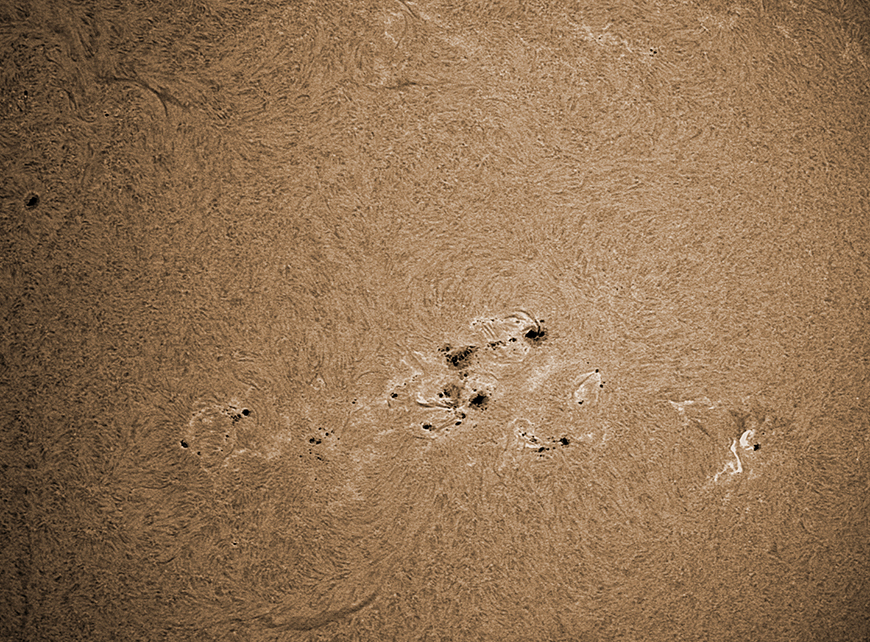
The Sun's surface through a Lunt LS80 B1200, 20th April 2024: showing Sunspot regions 3645, 3647, 3637 and 3638, by Chris Bailey. Image used with kind permission.
April saw yet more low latitude Aurora being observed, with a particularly bright display being seen from Europe on the evening of the 16th. This was caused by a reasonably powerful M1 class flare, from a coronal hole that just happened to be pointed in the orientation of the Earth.
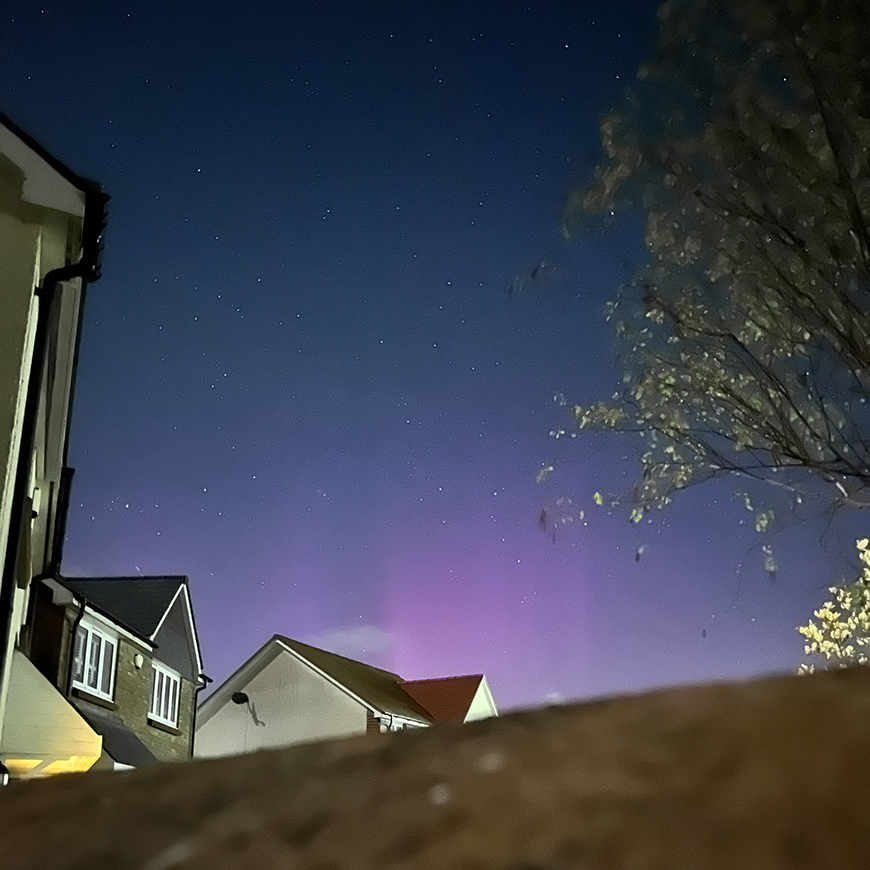
Purple Aurora Borealis, captured by Kerin Smith, from East Devon, UK, 16th April 2024.
As we’ve previous mentioned, websites such as www.spaceweather.com and Michel Deconinck’s monthly newsletter: https://astro.aquarellia.com/doc/Aquarellia-Observatory-forecasts.pdf cover many aspects of solar observations and are well worth checking out.
The Moon
Our natural satellite begins May in the constellation of Capricornus, it is at last quarter phase on the 1st of May, rising at a little before 3:30am (from 51° north), and setting at a little after 11:30 am. The next week will find the Moon tracking closer and closer to the sun. It will leave Capricornus, passing through neighbouring Aquarius where it will come into close proximity with planet Saturn on the mornings of the third and fourth, before crossing the border into Pisces where it will pass by Mars and Neptune on the morning of the fifth. Briefly crossing over the borders into the non-zodiacal constellation of Cetus, Mars will rejoin Pisces coming into close proximity with the planet Mercury on the morning of the 6th - at this point, both the Moon and Mercury will be fairly difficult to pick up in the glare of the dawn sky.
The Moon will reach new phase on May 8th when it joins the Sun in the constellation of Aries. Beyond this point, it becomes an evening object: rapidly rising through Taurus, before skirting the borders between Gemini and Auriga, then crossing Gemini on the 12th and 13th of May. It then enters the constellation of Cancer, moving to the north of the famous Beehive cluster during the early hours of the 14th, before reaching first quarter in Leo on the evening of the 15th.
The Moon will then cross the expanses of both Leo and neighbouring Virgo over the next week, before crossing the slightly more diminutive zodiacal constellation of Libra and on into Scorpius, where it will be found reaching Full Moon in the early hours of May 23rd. It is customary at this point in the sky guide that we remind readers that this part of the month will not be the most opportune for observing and imaging fainter deep sky targets - though as we have previously covered, the encroachment of permanent astronomical twilight at this time of the year also compound this for many observers. By this point in the month, the Moon will rise at a little after 7 pm, transiting at a little before midnight and setting at a little after 4 am (all times BST).
The Moon will then transition through Scorpius and into the non-Zodiacal constellation of Ophiuchus, before reaching the most southerly point of the ecliptic in Sagittarius on the 26th.
From then on, the Moon will begin to slowly climb in the ecliptic in a sedately northerly direction, before ending the month in close proximity to Saturn in Aquarius, on the 31st. By this point in time it will be back to just past last quarter phase, where we found it at the month’s beginning
Mercury
The solar system’s smallest true planet starts of May as a morning object in Pisces. At +1.1 magnitude showing an apparent size of 9.6 seconds and just below 27% illumination, the crescent Mercury will stand just under 4 1/2° above the horizon as the Sun rises (as observed from 51° north) at the beginning of the month, so will be a challenging target at best. At this point in time, the planet will be about 24° to the west of the Sun.
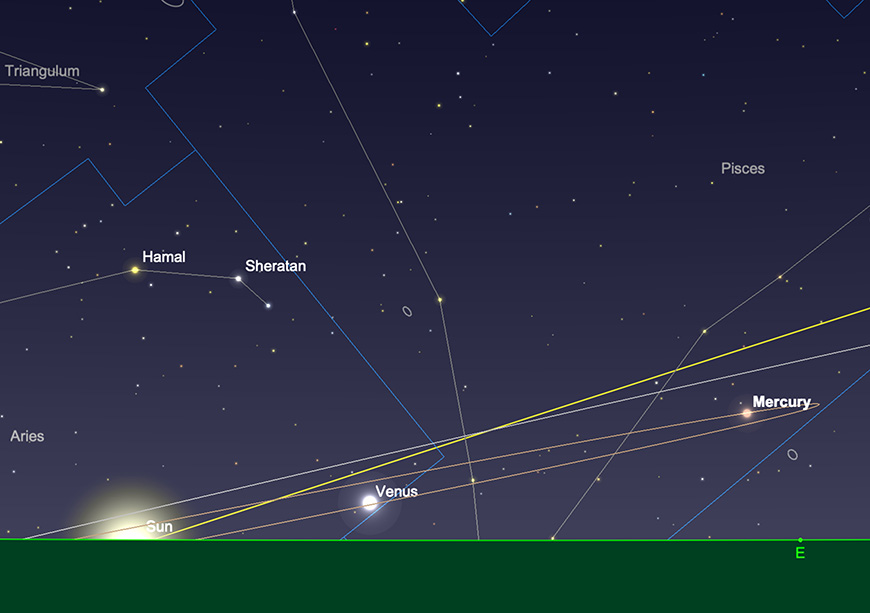
Mercury at sunrise, 1st May. Image created with SkySafari 6 for Mac OS X, ©2010-2016 Simulation Curriculum Corp., skysafariastronomy.com.
As the month progresses, Mercury continues to draw away from our parent star, eventually reaching maximum western elongation on the 9th of May. By this point in the month it will be found just under 26 1/2° from the Sun. On the morning of the 9th, Mercury will show a +0.6 arc second diameter disc, which has increased its illumination to just over 40%. As the planet is drawing away from us, it will have reduced its size by a little to 8.2 seconds, as compared to the month’s beginning.
By mid-May, Mercury will have increased its elimination fracture to +0.3 magnitude and will now show a 7.5 arc second diameter desk illuminated by just under 49%. The situation in regards to Mercury’s height above the horizon, as seen from higher Northern latitudes, has not really changed much, the morning of the 15th find it 5 and 3/4° above the horizon (again, as observed from 51° north), at sunrise.
By the time we get to the end of May, Mercury has brightened significantly to -0.7 magnitude and now displays a 5.7 arc second diameter disc. The planet is now illuminated by just under 80% having swung around the Sun from our perspective here on Earth. Mercury’s separation from the Sun has decreased to a little over 16° on the morning of the 31st. The planet sits a little above 4 1/2° above the horizon as the Sun rises (from 51° north). Now a resident of Taurus, Mercury continues to be a challenge to observe for those of us located in higher northern latitudes.
Venus
Found in roughly the same area of sky as its neighbour, Mercury, Venus is also a great challenge to find at all from higher northern latitudes. It is headed towards the Sun from our perspective on Earth, swinging around behind our parent star in early June 2024. Venus is always brilliant, but its altitude above the horizon (as observed from 51° north), on the 1st May, means practically nobody will be able to find it. The planet sits just one and a quarter degrees above the horizon as the Sun comes up.
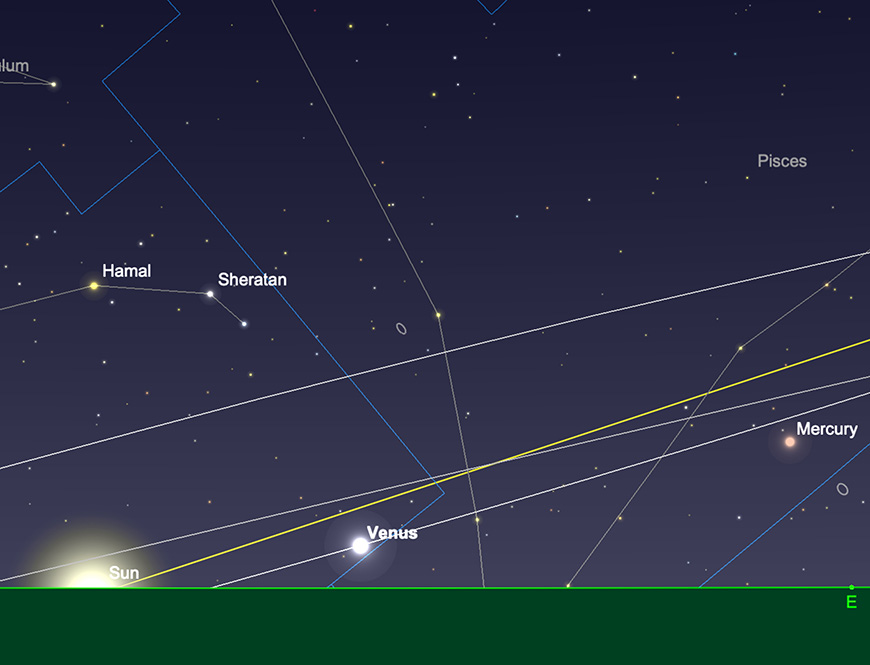
Venus at sunrise, 1st May. Image created with SkySafari 6 for Mac OS X, ©2010-2016 Simulation Curriculum Corp., skysafariastronomy.com.
The rest of May finds Venus inching closer and closer towards the Sun and as a result being yet more of a challenge to observe at all, as time goes on. Due to Venus’ proximity to the Sun and its difficult elevation, we can safely say that there are much better planetary targets to attempt to find this month. Venus ends May at just over a degree’s separation from the Sun.
Mars
Sitting much further to the west of the Sun in the morning sky than either Venus or Mercury, Mars is still a reasonably diminutive target for meaningful observation at present. The morning of the 1st sees Mars a resident of Pisces, shining at steady, if unspectacular, +1.1 magnitude and displaying a small 4.7 arc second diameter disc. At this point in time, the planet will stand just over 10° high above the horizon at sunrise (as observed from 51° north) and will sit just over 40° to the west of the Sun.
By the time we get to mid-May, Mars remains static in brightness at +1.1 magnitude, but has gained a little in altitude, sitting just over 12 1/4° above the horizon in the east, as the Sun rises.
Progressing to the end of May and very little has changed. Mars remains at a visual magnitude of +1.1, but has gained a tiny amount in terms of angular size for the month’s beginning and now shows a five arc second diameter disc. The Red Planet will sit just below 16° high above the horizon as the Sun comes up. We are still eight months away from the next Martian opposition and will have to bide our time as far as meaningful observations of the red planet go until closer to this point.
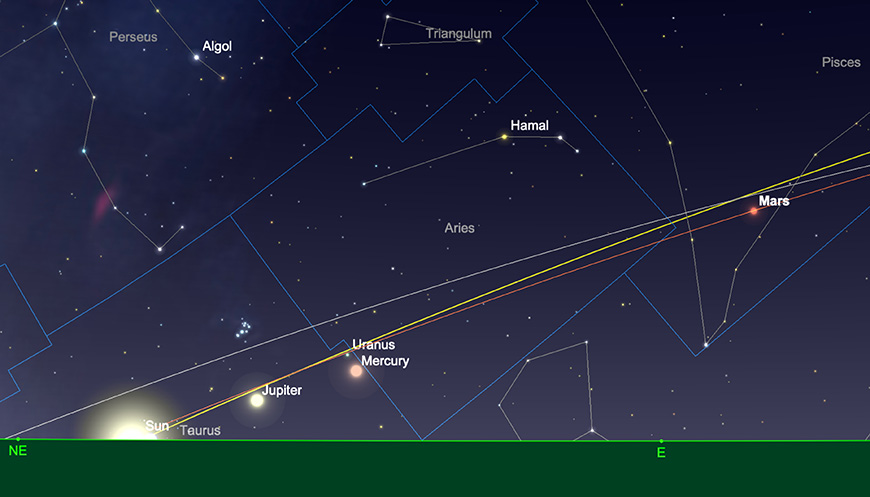
Mars, sunrise, 31st May. Image created with SkySafari 6 for Mac OS X, ©2010-2016 Simulation Curriculum Corp., skysafariastronomy.com.
Jupiter
As reported in last month’s sky guide, the window for evening of observations of Jupiter is rapidly shutting. We find Jupiter on the evening of the 1st, separated from the Sun by just under 12 1/2° and sitting in Taurus at -2 magnitude. The planet will not be especially difficult to spot for those of us in higher northern latitudes, as it will remain bright, but setting just under an hour after the Sun and sitting so low before doing so, will not encourage observation.
Jupiter reaches superior conjunction on May 18th, passing to the south of the Sun in Taurus. After superior conjunction, it will re-emerge as a morning target, though will be some time before it has gained significant separation from the Sun and can be observed again.
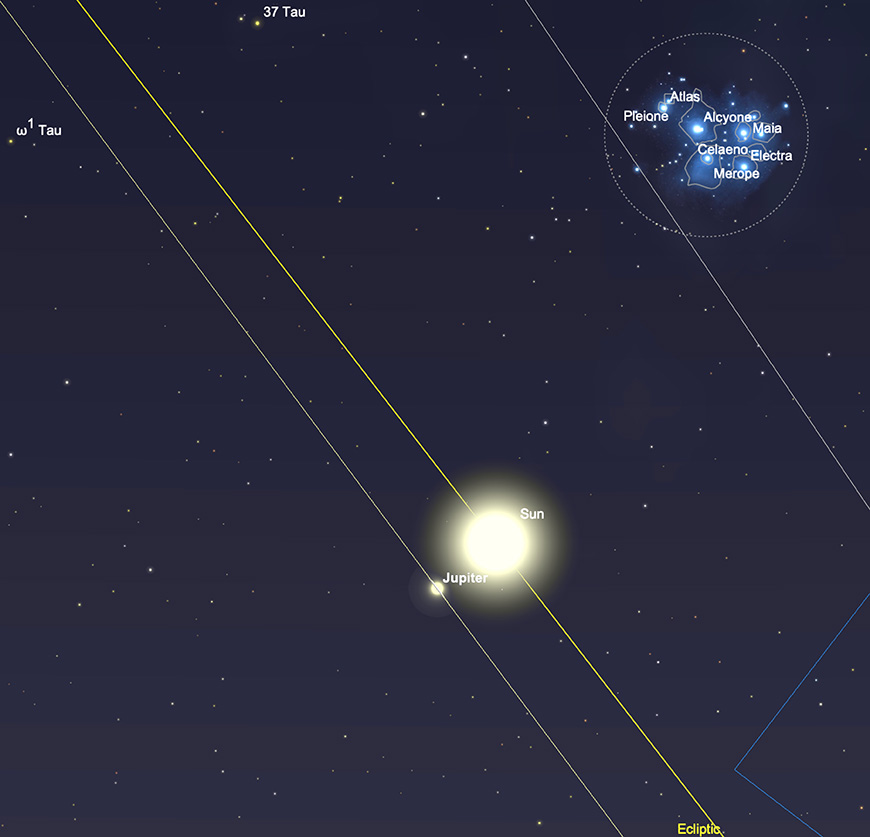
Jupiter, superior conjunction 18th May. Image created with SkySafari 6 for Mac OS X, ©2010-2016 Simulation Curriculum Corp., skysafariastronomy.com.
We end May with Jupiter a morning target, separated from the Sun by 9°. The King of the Planets will stand around 2 1/2° high above the horizon as the Sun rises (as observed from 51° north) making it a very difficult target to find, at best.
Although Jupiter is in a disappointing part of the sky now, we can content ourselves that towards the end of 2024, closer to when Jovian opposition takes place, the planet will be in an extremely good position for northern hemisphere observers. Patience is required until then.
Saturn
A resident of Aquarius, Saturn sits further to the west of the Sun than any other of the major planets that appear in the morning sky at this time. At +1.2 magnitude, showing an apparent size of 16.2 arc second diameter, the planets will sit at just over 12 1/2° above the horizon (as observed from 51° north) at sunrise in the morning of the 1st.
By mid-month, not much has changed to as far as Saturn is concerned. It has increased its angular size to 16.5 arc seconds, though this has made no difference to its apparent brightness. The Ringed Planet sits at just under 17° elevation above the horizon (again, as observed from 51° north), as the Sun comes up on the morning of the 15th.
By the end of the month, Saturn remains static in brightness at +1.2 magnitude, now showing 17 arc second diameter disc.
The morning of the 31st finds Saturn being joined in Aquarius by the last quarter Moon, with the two bodies separated from each other by a little under 3°. The Moon’s proximity to at Saturn this point will make it relatively straightforward to find the planet in the sky for those unfamiliar with its position. Saturn will stand just over 22° high above the horizon (from 51° north) as the Sun rises on the morning of the 31st.
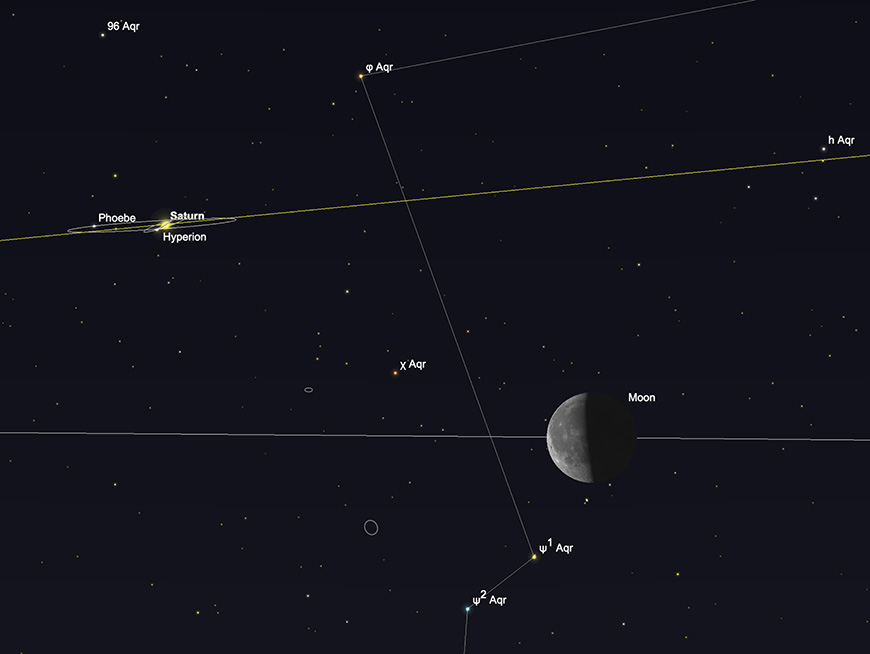
Saturn and the Moon, sunrise, 31st May. Image created with SkySafari 6 for Mac OS X, ©2010-2016 Simulation Curriculum Corp., skysafariastronomy.com.

 English
English

